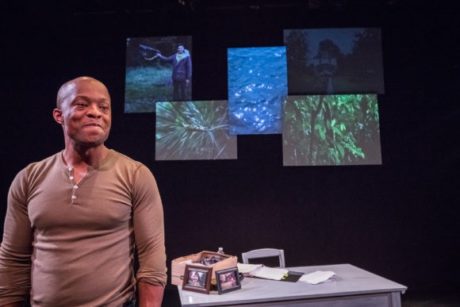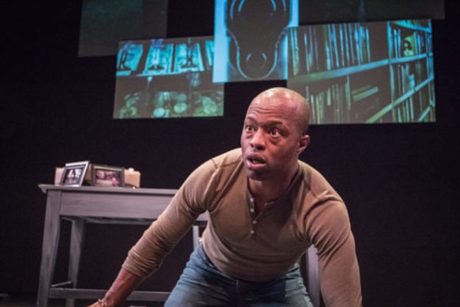Among the issues polarizing America (and degrading public discourse) is the hot-button question of what to do about guns. Proponents of positions right and left talk past each other. Both camps have unassailable certitude on their side. Playwright E.M. Lewis set out to see if she could bridge the divide.
She chose to tell autobiographical stories about her own relationship to guns in the form of a solo performance piece. But rather than step onstage herself to tell the stories, she chose to have them told by a male actor—”for distance” as her script explains. Thus as performed with prodigious virtuosity by Vin Shambry, Lewis’s The Gun Show became as riveting for its form as for its content.

The production directed by Shawn Lee originated in Portland, Oregon, where he, Lewis, and Shambry are based, and stopped off on its tour for a brief run in 1st Stage’s Logan Festival of Solo Performance on its way to the Edinburgh Fringe Festival in August. (How a play about America’s firearms impasse will play in Scotland—a country that prohibits all handguns, semi-automatic, and pump-action non-rim-fire rifles—should be interesting.)
The set is black-box simple. A chair and table with some props. A standing work light. A projection screen on which can be seen a montage of closeups of gun parts. As we enter, the low sound of rounds being fired at a shooting gallery.
Shambry is a transfixing performer and owns the stage. He begins vividly describing a shoot-’em-up scene in the movie Reservoir Dogs. He makes the point we sometimes “can’t tell the difference between real life and a Tarantino movie.” We think he is playing a black man confronting gun violence because that’s who we see before us. And then we realize the lines he is speaking are Lewis’s. Not just because she wrote them; she lived them. When Shambry speaks, for instance, of “my husband,” he means hers.

Shambry shines a flashlight on Lewis’s face in the audience. She is sitting there, as she has been for all performances. She wrote herself into the script as a silent witness to the telling of her story. As a writer, as a woman, her script explains, she felt the story needed to be told in a man’s voice. At the point when we realize that she herself is in the house, whatever line there is between life and art completely blurs, and we ourselves are witness to something far more than theater.
Shambry (as Lewis) promises to tell five stories and does so. One is a story about how Lewis grew up around and with guns. They were familiar in her family. He (as she) asks those who did not come from such a background and/or who would not want guns around: “How far from law enforcement do you live?” If a violent criminal was to break into your home and 911 is an hour away, wouldn’t you rather be able to defend yourself? The point lands. In a similar vein, he (as she) tells a story about an armed robbery in a Portland bookstore where she worked.
And then he (as she) tells the story of how she learned to shoot. She was expertly instructed by a 29-year-old man she met when she was 19, the man named Irving whom she would marry. And from then on, the politically challenging story of The Gun Show is also the moving, and sometimes heartbreaking, story of a marriage.
The issue of guns is more complicated than right and left, says the script. “The commentary is killing the conversation.” We need to talk from what we have in common: We all want to be safe. “What’s stopping us from figuring this out?”
Lewis’s script spells out the conundrum: Guns ≠ safety. No guns ≠ safety. The last story is a tragedy that brings that point home.
Projection Designer Kristeen Willis Crosser punctuated the solo performance with sometimes witty images: blown-up stage directions, for instance. Lighting Designer Pablo Santiago brought intimacy to the vast stage space, Sound Designer Rodolfo Ortega amplified the story telling subtly (no ear-shattering gunshots, thankfully), and Costume Designer Gregory Pulver gave Shambly casual clothes to match his personable stage presence.
Distilling the problem of guns in America to its particulars in the life of one woman from the Northwest of Norwegian descent brings a sharp focus to what’s personal and intractably complicated about the issue. And the device of having her story told by a man, in this case a black man, is remarkably effective in showing us the universal patterns in those particulars, without the option to dismiss what’s being said because a woman’s voice on stage still does not say “human experience” with the gravitas that a man’s does.
And yet, if the stories being told were from a black man’s life—portrayed on stage by an actor who fit the part—the particulars would be dramatically different. If he were to talk about what’s complicated about the gun debate, for instance, he would have to reference the death of Philando Castile, the black man who was shot by a white police officer upon stating the fact that he was carrying a licensed firearm, as was his Second Amendment right.
The Gun Show doesn’t go there. Yet it leaves us with the lesson that what’s complicated always has personal context and cannot be abstracted apart from individual lived lives. As such truthful storytelling about complexity goes, The Gun Show sets a brave example, with a terrific script brilliantly played.
Running Time: One hour, with no intermission.
The Gun Show was one of three works in The Logan Festival of Solo Performance, which ran July 6-16, 2017, at 1st Stage – 524 Spring Hill Road, in Tysons, VA.
LINKS:
In the Moment: Logan Festival of Solo Performance at 1st Stage by
Review: ‘Hick: A Love Story’ at 1st Stage by
Review: ‘Empanada For A Dream’ at 1st Stage by





Photo Credit Owen Carey
Fixed. Thanks for the catch.